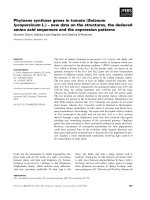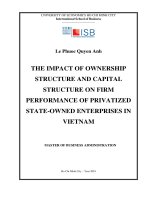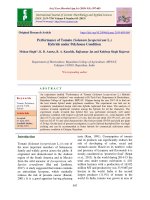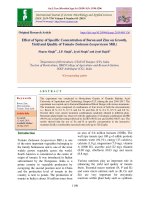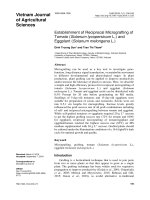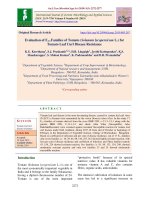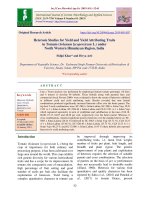Performance of tomato (Solanum lycopersicum L.) in acid soil under integrated nutrient management with biochar as a component
Bạn đang xem bản rút gọn của tài liệu. Xem và tải ngay bản đầy đủ của tài liệu tại đây (267.95 KB, 11 trang )
Int.J.Curr.Microbiol.App.Sci (2019) 8(5): 793-803
International Journal of Current Microbiology and Applied Sciences
ISSN: 2319-7706 Volume 8 Number 05 (2019)
Journal homepage:
Original Research Article
/>
Performance of Tomato (Solanum lycopersicum L.) in Acid Soil under
Integrated Nutrient Management with Biochar as a Component
Oguboyana Srikanth Yadav and Sanjay Swami*
School of Natural Resource Management, College of Post Graduate Studies in Agricultural
Sciences, Central Agricultural University, Umiam-793103, Meghalaya, India
*Corresponding author
ABSTRACT
Keywords
Biochar, INM,
Acidic soils, North
eastern hill region,
Tomato
performance
Article Info
Accepted:
10 April 2019
Available Online:
10 May 2019
Majority of the soils in the North Eastern Hill (NEH) region of India are acid in reaction
causing low crop yields. The region produces huge quantity of crop residue/weed biomass
which can be converted into biochar for managing soil acidity. To evaluate the
performance of tomato (cv. Megha tomato-2) in acid soil of Meghalaya under integrated
nutrient management having biochar as a component, an experiment was conducted during
rabi season of 2017-18 at Research Farm of School of Natural Resource Management,
CPGSAS, Umiam, Meghalaya and the following sixteen treatments were tested under
RBD with three replications: T 1 - Control, T2 - B @ 2 t/ha, T3 - B @ 3 t/ha, T4 - B @ 4
t/ha, T5 - 75% RDF + B @ 2 t/ha, T6 - 75% RDF + B @ 3 t/ha, T7 - 75% RDF + B @ 4
t/ha, T8 - 75% RDF + B @ 2 t/ha + VC @ 2.5 t/ha, T9 - 75% RDF + B @ 3 t/ha + VC @
2.5 t/ha, T10 -75% RDF + B @ 4 t/ha + VC @ 2.5 t/ha, T11 - 100% RDF + B @ 2 t/ha, T12 100% RDF + B @ 3 t/ha, T13 - 100% RDF + B @ 4 t/ha, T14 - 100% RDF + B @ 2 t/ha +
VC @ 2.5 t/ha, T15 - 100% RDF + B @ 3 t/ha + VC @ 2.5 t/ha, T16 - 100% RDF + B @ 4
t/ha+ VC @ 2.5 t/ha. The experimental results revealed that the highest plant height (cm)
and number of fruits/plant was recorded in the treatment T16 - 100% RDF + B @ 4 t/ha +
VC @ 2.5 t/ha with 150 and 127 percent increase over control, respectively. Average fruit
weight (66.12 g), fruit yield (38.85 t/ha), fruit dry matter (5.22 t/ha) and haulm dry matter
(3.19 t/ha) was recorded highest in the treatment T16 - 100% RDF + B @ 4 t/ha + VC @
2.5 t/ha which were significantly higher over all other treatments indicating that the
application of biochar @ 4 t/ha in combination with vermicompost @ 2.5 t/ha and 100%
RDF was most effective in increasing tomato yield in acid soil than sole application of
biochar or biochar in combination with recommended doses of chemical fertilizers.
is acidic, of which 26 million ha of area
having soil pH<5.5 and the rest 23 million ha
of area having soil pH range 5.6 to 6.5.
Approximately, 84 per cent of the soils in the
North Eastern Hill (NEH) region of India are
acidic in reaction, having low available
Introduction
Soil is the basic foundation for sustainable
crop production and the soil quality effects
crop production. Out of 142 million ha of
cultivable area in India, 49 million ha of area
793
Int.J.Curr.Microbiol.App.Sci (2019) 8(5): 793-803
phosphorus (P) and zinc whereas toxicity of
iron and aluminium (Lyngdoh and SanjaySwami, 2018). In acid soils, P adsorption is
generally attributed to hydrous oxides of iron
and aluminium. There is great possibility that
some natural phosphates of aluminium or iron
(such as variscite and strengite) may formed
in these soils making P the most limiting
nutrient for crop production (Sanjay-Swami
and Maurya, 2018; Sanjay-Swami et al.,
2019). In Meghalaya, the acid soils are found
under different acidic ranges like moderately
acidic soils (1.19 million ha), and slightly
acidic soils (1.05 million ha) (Maji et al.,
2012). The soils of Meghalaya are high in
organic carbon, which is a measure of
supplying potential of soil nitrogen, deficient
in available phosphorous, medium to low in
available potassium, calcium, magnesium and
toxic in Al and Fe. To overcome the problem
of soil acidity, farmers adopt variety of soil
amendments like manures, lime and composts
to make soil nutrients available to crops as
well as to protect them from the toxic
elements. Among soil amendments, liming is
good practice to overcome the acidity
problem; however, it may not be economical
in the regions where it is expensive. Biochar
is an alternative, good and cheap organic
source to overcome the soil acidity problem
(Chan et al., 2008, Yadav and Sanjay-Swami,
2018).
on maintaining of specific temperature
(Demirbas, 2004; Sanjay-Swami et. al.,
2018). Temperature of 400-5000 C produces
more quantity of biochar, while temperatures
above 7000 C favour the yield of liquid and
gas fuel components. The major resource
required for the production of the biochar is
organic residue. The NEH region produces
huge quantity of crop residue/weed biomass
which can be converted into biochar for
managing soil acidity (Yadav and SanjaySwami, 2018). Soil health management in the
fragile ecosystems of the NEH region should
be based on recycling of available plant
residues, agro-forestry, and integrated nutrient
management (Sanjay-Swami, 2019). Biochar
has numerous beneficial effects to soils used
for agricultural purposes. The application of
charcoal to the soil for improving its physical
condition is an old practice (Renner, 2007).
There are reports in the literature that biochar
in combination with inorganic fertilizers had
shown significant increase in yield of cowpea,
maize and peanut (Yamato et al., 2006),
paddy (Zhang et al., 2012), spring barley,
winter wheat, carrots, spinach, oilseed rape,
peas and beetroot (Hammond et al., 2013).
However, meager information is available on
integrating biochar with organic manures and
chemical fertilizers. Therefore, the present
investigation was carried out to evaluate the
performance of tomato (cv. Megha tomato-2)
in acid soil of Meghalaya under integrated
nutrient management having biochar as a
major component.
Biochar is a carbonaceous solid material
obtained from thermally degrading biomass in
the absence of oxygen or presence of little
oxygen. It is commonly defined as charred
organic matter, produced with the intention to
apply in the soils to sequester carbon and
improve soil physical and chemical properties
(Lehmann and Joseph, 2009). It is produced
by processes called pyrolysis, the direct
thermal decomposition of biomass in the
absence of oxygen which produces a mixture
of solids (biochar), gas (syngas) and liquid
(bio oil). Yield and quality of biochar depends
Materials and Methods
A field experiment was conducted during rabi
season of 2017-18 at Research Farm of
School of Natural Resource Management,
College of Post Graduate Studies in
Agricultural Sciences (CPGSAS), Umiam,
Ri-bhoi district, Meghalaya which is located
at 91018’ to 92018’ E longitude and 25040’
to 26020’ N latitude with an altitude of 950 m
794
Int.J.Curr.Microbiol.App.Sci (2019) 8(5): 793-803
above the mean sea level. The experimental
area falls under subtropical humid climate
with high rainfall and cold winter. Tomato cv.
Megha tomato-2 was used as test crop with
three doses of biochar (B) @ 2, 3 and 4 t/ha,
vermicompost (VC) @ 2.5 t/ha and two
graded recommended doses of NPK fertilizers
(RDF) @ 75 and 100%. The trial was
replicated three times adopting Randomized
Block Design (RBD) with 16 treatment
combinations namely, T1 - Control, T2 - B @
2 t/ha, T3 - B @ 3 t/ha, T4 - B @ 4 t/ha, T5 75% RDF + B @ 2 t/ha, T6 - 75% RDF + B
@ 3 t/ha, T7 - 75% RDF + B @ 4 t/ha, T8 75% RDF + B @ 2 t/ha + VC @ 2.5 t/ha, T9 75% RDF + B @ 3 t/ha + VC @ 2.5 t/ha, T10 75% RDF + B @ 4 t/ha + VC @ 2.5 t/ha, T11
- 100% RDF + B @ 2 t/ha, T12 - 100% RDF +
B @ 3 t/ha, T13 - 100% RDF + B @ 4 t/ha,
T14 - 100% RDF + B @ 2 t/ha + VC @ 2.5
t/ha, T15 - 100% RDF + B @ 3 t/ha + VC @
2.5 t/ha, T16 - 100% RDF + B @ 4 t/ha+ VC
@ 2.5 t/ha. The experimental soil was acidic
in reaction having pH 5.1 and medium in
available phosphorus (18.70 kg/ha). The
detailed analysis of experimental soil is
presented in Table 1.
Results and Discussion
Plant height (cm)
Plant height is the observable parameter
which helps to assess the effectiveness of
various treatments. The plant height of tomato
recorded under different treatments is
presented in Table 3. The highest plant height
(56.2 cm) was recorded with the application
of 100% RDF + biochar @ 4 t/ha +
vermicompost @ 2.5 t/ha (T16), whereas the
lowest plant height (37.4 cm) was observed
under control plots (T1). The sole application
of biochar @ 2 t/ha slightly increased plant
height over control plots (T1). Further,
successive increase in biochar doses i.e. 3 and
4 t/ha also increased plant hight over each
lower doses of biochar. Biochar has been
reported to modify soil quality characteristics.
As it was alkaline in nature (pH 8.6),
probably the pH of acidic soil under study
(5.1) improved, thereby increasing crop
growth and yields. The similar findings were
also reported by Novak et al., (2013).
The combined application of 75% RDF and
biochar markedly increased the plant height
over sole application of biochar at respective
graded doses, whereas the combination of
75% RDF + biochar + vermicompost @ 2.5
t/ha significantly increased the plant height
over sole application of biochar at respective
graded doses. A close scrutiny of data also
revealed that the combined application of
100% RDF and biochar significantly
increased the plant height over sole
application of biochar at respective graded
doses, however, the addition of vermicompost
@ 2.5 t/ha with 100% RDF and biochar
further increased the plant height over 100%
RDF and biochar at respective graded doses.
The research findings with respect to plant
height are also in concurrence with the
findings of Mohideen (2018) who observed
better growth of chilli with the application of
The biochar utilized in this study was
prepared through pyrolysis by using waste
from the plywood industry as a feedstock
source at ICAR Research Complex for NEH
Region, Umiam whereas vermicompost was
procured from Rural Resource and Training
Centre, Umran. The characteristics of biochar
and vermicompost along with the method of
analysis are provided in Table 2.
The biochar and vermicompost at required
rate were applied 15 days before transplanting
of tomato seedlings and mixed well in the
surface soil. The growth and yield parameters
of tomato were recorded at maturity. The data
recorded for various parameters were
analysed statistically by following procedure
of Gomez and Gomez (1984).
795
Int.J.Curr.Microbiol.App.Sci (2019) 8(5): 793-803
Gliciridia biochar + 100% urea over sole
applications. The probable reason for further
improvement in plant height with the addition
of vermicompost along with 100% RDF and
biochar is the additional supply of plant
nutrients as well as improvement in physical
and biological properties of soil by
vermicompost (Sanjay-Swami and Bazaya,
2010; Konyak and Sanjay-Swami, 2018;
Gupta et al., 2019).
Average fruit weight (g)
The sole application of biochar @ 2 t/ha
markedly and significantly increased average
fruit weight (g) of tomato over control plots
(T1), however, further successive increase in
biochar doses i.e. 3 and 4 t/ha slightly
increased average fruit weight over each
lower doses of biochar (Table 3). The
combined application of 75% RDF and
biochar significantly increased the average
fruit weight over sole application of biochar at
respective graded doses. Similarly, the
inclusion of vermicompost @ 2.5 t/ha with
75% RDF + biochar significantly increased
the plant height over 75% RDF and biochar at
respective graded doses. However, nonsignificant increase in average fruit weight
was observed with further increase in RDF to
100% in combination with biochar over 75%
RDF and biochar at respective graded doses.
The examination of data further revealed that
the combined application of 75% RDF +
biochar + vermicompost @ 2.5 t/ha was
superior over 100% RDF and biochar at
respective graded doses with more average
fruit weight. However, the addition of
vermicompost @ 2.5 t/ha with 100% RDF +
biochar further increased the average fruit
weight over 100% RDF and biochar at
respective graded doses and the maximum
average fruit weight (66.12 g) was observed
with the application of 100% RDF + biochar
@ 4 t/ha + vermicompost @ 2.5 t/ha (T16).
Number of fruits/plant
Number of fruits/plant was recorded least
(7.40) in control plots which slightly
increased with each successive higher doses
of biochar (Table 3). The combined
application of 100% RDF and biochar
significantly increased the number of
fruits/plant over sole application of biochar at
respective graded doses and it was at par with
the combined application of 75% RDF +
biochar + vermicompost @ 2.5 t/ha at
respective graded doses of biochar. The
number of fruits/plant further increased with
the addition of vermicompost @ 2.5 t/ha with
100% RDF and biochar at respective doses of
biochar and the maximum number of
fruits/plant was recorded in the treatment
receiving 100% RDF + biochar @ 4 t/ha +
vermicompost @ 2.5 t/ha (T16).
The increased number of fruits/plants
observed under study may be due to the fact
that number of fruits are dependent on canopy
size and vigour of plants which is observed
higher under T16 with 100% RDF + biochar
@ 4 t/ha + vermicompost @ 2.5 t/ha. These
results corroborate the findings of Antonious
(2018) who reported that addition of biochar
(1% w/w) to sewage sludge (SS) and yard
waste (YW) treatments significantly increased
number of fruits/plant in tomato indicating a
positive effect of biochar on the growth at
University
of
Kentucky,
Lexington,
Kentucky.
The higher average fruit weight recorded with
the application of biochar over control is
possibly due to improvement in soil
properties and increased nutrient availability
(Lehmann et al., 2003; Oguntunde et al.,
2004; Lehmann et al., 2006; Deluca et al.,
2009). However, the addition of biochar with
RDF significantly increased the nutrient
availability due to increased nutrients supply
maintained by chemical fertilizers. These
results are in agreement with the findings of
796
Int.J.Curr.Microbiol.App.Sci (2019) 8(5): 793-803
Mohideen (2018) who also reported
improvement in average fruit weight of chilli
with the application of Gliciridia biochar +
100% urea over sole applications. Further,
inclusion of vermicompost @ 2.5 t/ha with
100% RDF + biochar further improved
average fruit weight of tomato due to
combined beneficial effect. The beneficial
effect of vermicompost on average fruit
weight might be due to additional supply of
plant nutrients as well as improvement in
physical and biological properties of soil
(Sanjay-Swami and Bazaya, 2010; Konyak
and Sanjay-Swami, 2018; Gupta et al., 2019).
The highest average fruit weight (66.12 g)
observed under T16 corroborates the findings
of CRIDA (2016).
respective graded doses. However, the
addition of vermicompost @ 2.5 t/ha with
100% RDF + biochar further increased the
fruit yield over 100% RDF and biochar at
respective graded doses and the maximum
fruit yield (38.86 t/ha) was recorded with the
application of 100% RDF + biochar @ 4 t/ha
+ vermicompost @ 2.5 t/ha (T16).
Application of biochar significantly increased
fresh fruit yield of tomato over control.
Lehmann et al., (2003) also observed the
immediate beneficial effects of biochar
addition to soil due to higher P availability,
because it may contribute as a source of
available and exchangeable P, ameliorator of
P complexing metals (Ca2+, Al3+ and Fe3+, 2+),
as a promoter of microbial activity and P
mineralization (Deluca et al., 2009). The
results obtained under present investigation
also confirmed the findings of Oguntunde et
al., (2004) who compared maize yields
between disused charcoal production sites and
adjacent fields, Kotokosu watershed, Ghana
and observed 91 per cent higher grain yield
and 44 per cent higher biomass yield on
charcoal site than control. Lehmann et al.,
(2006) again advocated that biochar
application boosts up the soil fertility and
improves soil quality by raising soil pH,
increasing moisture holding capacity,
attracting more beneficial fungi and microbes,
improving cation exchange capacity and
retaining nutrients in soil, thereby increasing
crop yields.
Fresh fruit yield (t/ha)
The fresh fruit yield of tomato under different
treatment varied from 8.32 to 38.86 t/ha
(Table 4). The data indicated that the sole
application of biochar at different graded
doses i.e. 2, 3 and 4 t/ha significantly
increased the fruit yield over control plots
(T1) which recorded lowest fruit yield (8.32
t/ha). However, successive increase in biochar
doses from lowest level of 2 t/ha to 3 and 4
t/ha slightly increased fruit yield over lower
doses. The combined application of 75% RDF
and biochar significantly increased the fruit
yield over sole application of biochar at
respective graded doses as well as over
control plots. Further, significant increase in
fruit yield was observed with subsequent
increase in RDF to 100% in combination with
biochar over 75% RDF and biochar at
respective graded doses. Similarly, the
inclusion of vermicompost @ 2.5 t/ha with
75% RDF + biochar significantly increased
the fruit yield over 75% RDF and biochar at
respective graded doses. The fruit yield
obtained with 75% RDF + biochar +
vermicompost @ 2.5 t/ha was observed to be
superior over 100% RDF and biochar at
The addition of biochar with RDF also
significantly
increased
the
nutrient
availability due to increased nutrient supply
through chemical fertilizers. Yamato et al.,
(2006) also reported that Acacia bark charcoal
plus fertilizer increased maize and peanut
yields in area of low soil fertility. Inclusion of
vermicompost @ 2.5 t/ha with 100% RDF +
biochar further improved average fruit weight
of tomato that might be due to combined
797
Int.J.Curr.Microbiol.App.Sci (2019) 8(5): 793-803
beneficial effect biochar and vermicompost in
maintaining additional supply of plant
nutrients as well as improvement in physical
and biological properties of soil (SanjaySwami and Bazaya, 2010; Konyak and
Sanjay-Swami, 2018; Gupta et al., 2019). The
maximum fruit yield (38.86 t/ha) recorded
with the application of 100% RDF + biochar
@ 4 t/ha + vermicompost @ 2.5 t/ha (T16) is
in agreement with the findings of CRIDA
(2016) wherein eight treatments viz. T1 Control, T2 - RDF (120-60-60), T3 - Biochar
(2 t/ha), T4 - Biochar (4 t/ha), T5 - RDF +
Biochar (2 t/ha), T6 - RDF + Biochar (4 t/ha),
T7 - RDF + Biochar (2 t/ha) + FYM (5 t/ha),
T8 - RDF + Biochar (4 t/ha) + FYM (5 t/ha)
were tested in a rainfed Alfisol (Typic
Haplustalf) to evaluate maize (DHM 117)
performance and observed maximum yield
with RDF + Biochar (4 t/ha) + FYM (5 t/ha).
Fruit and haulm dry matter (t/ha)
The highest fruit and haulm dry matter yield
of tomato was recorded as 5.22 and 3.19 t/ha
with the application of 100% RDF + biochar
@ 4 t/ha + vermicompost @ 2.5 t/ha (T16)
which was approximately 6 and 7 fold more
over control plots (Table 4). The fruit and
haulm dry matter of tomato significantly
increased with the sole application of biochar
at different graded doses i.e. 2, 3 and 4 t/ha
over control plots (T1) which recorded lowest
fruit and haulm dry matter (0.86 and 0.46
t/ha).
Table.1 Physico-chemical properties of experimental soil along with methods followed for
analysis
Parameters
Value
5.10
0.45
1.43
261.00
Methods
Potentiometry
pH
Conductometry
EC(dS/m)
3
Clod method
Bulk density (g/cm )
Alkaline potassium
Available N (kg/ha)
permanganate method
18.70
Brays No. 1
Available P2O5 (kg/ha)
235.15
Flame photometer method
Available K2O (kg/ha))
DTPA extractable micronutrients (ppm)
6.18
Iron
36.48
Zinc
Atomic absorption
48.43
Manganese
spectrophotometry
16.78
Copper
Soil acidity indices (cmol(p+)/kg)
3.02
Titrimetric determination
Exchangeable acidity
2.25
Titrimetric determination
Exchangeable
aluminium
1.33
Complexometric titration
Exchangeable Ca & Mg
method
7.33
Ammonium acetate
Cation exchange
saturation method
capacity
798
References
Jackson (1973)
Jackson (1973)
Campbell and Henshall (2001)
Subbiah and Asija (1956)
Jackson (1973)
Jackson (1973)
Lindsay and Norwell (1978)
Jackson (1973)
Jackson (1973)
Jackson (1973)
Jackson (1973)
Int.J.Curr.Microbiol.App.Sci (2019) 8(5): 793-803
Table.2 Characteristics of biochar and vermicompost used in the study along with methods
followed for analysis
Parameters
pH
EC (dS/m)
Nitrogen (%)
Biochar
8.60
1.77
0.61
Vermicompost
7.30
2.11
0.22
1.23
Phosphorus (%)
1.01
1.53
Potassium (%)
DTPA extractable micronutrients (ppm)
0.06
250.20
Iron
1.72
1095.00
Zinc
0.04
53.00
Manganese
0.12
248.60
Copper
Methods
Potentiometry
Conductometry
Kjeldahl digestion and
distillation method
Vanadomolybdate method
Flame photometer method
Atomic absorption
spectrophotometry
References
Jackson (1973)
Jackson (1973)
Jackson (1973)
Jackson (1973)
Jackson (1973)
Lindsay and Norwell (1978)
Table.3 Growth and yield attributing characters of tomato (Solanum lycopersicum L.) in acid
soil under integrated nutrient management with biochar as a component
Treatments
Plant height
(cm)
Number of
fruits/plant
Average fruit
weight (g)
T1 - Control
T2 - Biochar @ 2 t/ha
T3 - Biochar @ 3 t/ha
37.4
38.1
39.0
7.40
7.52
7.68
17.94
25.74
30.72
T4 - Biochar @ 4 t/ha
39.5
7.92
33.73
T5 - 75% RDF + Biochar @ 2 t/ha
T6 - 75% RDF + Biochar @ 3 t/ha
44.4
45.8
8.40
8.60
35.14
39.44
T7 - 75% RDF + Biochar @ 4 t/ha
47.8
8.72
42.75
T8 - 75% RDF + Biochar @ 2 t/ha +
Vermicompost @ 2.5 t/ha
T9 - 75% RDF + Biochar @ 3 t/ha +
Vermicompost @ 2.5 t/ha
T10 - 75% RDF + Biochar @ 4 t/ha +
Vermicompost @ 2.5 t/ha
T11 - 100% RDF + Biochar @ 2 t/ha
T12 - 100% RDF + Biochar @ 3 t/ha
47.2
8.68
41.47
53.6
9.12
49.73
55.1
9.32
56.08
46.7
49.8
8.64
8.92
41.39
45.15
T13 - 100% RDF + Biochar @ 4 t/ha
51.4
8.96
48.83
T14 - 100% RDF + Biochar @ 2 t/ha +
Vermicompost @ 2.5 t/ha
T15 - 100% RDF + Biochar @ 3 t/ha +
Vermicompost @ 2.5 t/ha
T16 - 100% RDF + Biochar @ 4 t/ha +
Vermicompost @ 2.5 t/ha
SE(m)±
48.7
8.84
45.20
54.0
9.24
55.52
56.2
9.40
66.12
2.51
0.44
2.15
CD(p≤0.05)
7.26
1.28
6.27
799
Int.J.Curr.Microbiol.App.Sci (2019) 8(5): 793-803
Table.4 Fresh fruit yield, fruit and haulm dry matter yield of tomato (Solanum lycopersicum L.)
in acid soil under integrated nutrient management with biochar as a component
Treatments
T1 - Control
T2 - Biochar @ 2 t/ha
T3 - Biochar @ 3 t/ha
T4 - Biochar @ 4 t/ha
T5 - 75% RDF + Biochar @ 2 t/ha
T6 - 75% RDF + Biochar @ 3 t/ha
T7 - 75% RDF + Biochar @ 4 t/ha
T8 - 75% RDF + Biochar @ 2 t/ha +
Vermicompost @ 2.5 t/ha
T9 - 75% RDF + Biochar @ 3 t/ha +
Vermicompost @ 2.5 t/ha
T10 - 75% RDF + Biochar @ 4 t/ha +
Vermicompost @ 2.5 t/ha
T11 - 100% RDF + Biochar @ 2 t/ha
T12 - 100% RDF + Biochar @ 3 t/ha
T13 - 100% RDF + Biochar @ 4 t/ha
T14 - 100% RDF + Biochar @ 2 t/ha
+ Vermicompost @ 2.5 t/ha
T15 - 100% RDF + Biochar @ 3 t/ha +
Vermicompost @ 2.5 t/ha
T16 - 100% RDF + Biochar @ 4 t/ha
+ Vermicompost @ 2.5 t/ha
SE(m)±
CD(p≤0.05)
Fresh fruit
yield (t/ha)
8.32
12.10
14.75
16.70
18.47
21.22
23.32
22.47
Fruit dry
matter (t/ha)
0.86
1.02
1.13
1.31
1.60
1.78
2.06
2.01
Haulm dry
matter (t/ha)
0.46
0.55
0.62
0.73
0.90
1.00
1.18
1.15
28.35
3.76
2.23
32.62
4.33
2.58
22.32
25.22
27.37
24.97
1.86
2.95
3.34
2.26
1.06
1.74
1.97
1.29
32.12
4.29
2.56
38.85
5.22
3.19
1.27
3.67
0.14
0.40
0.08
0.23
However, successive increase in biochar
doses from lowest level of 2 t/ha to 3 and 4
t/ha slightly increased fruit and haulm dry
matter over lower doses. The combined
application of 75% RDF and biochar
significantly increased the fruit and haulm dry
matter over sole application of biochar at
respective graded doses as well as over
control plots. Further, significant increase in
fruit and haulm dry matter was also observed
with subsequent increase in RDF to 100% in
combination with biochar over 75% RDF and
biochar at respective graded doses. Similarly,
the inclusion of vermicompost @ 2.5 t/ha
with 75% RDF + biochar significantly
increased the fruit and haulm dry matter over
75% RDF and biochar at respective graded
doses. The fruit and haulm dry matter
obtained with 75% RDF + biochar +
vermicompost @ 2.5 t/ha was observed to be
superior over 100% RDF and biochar at
respective graded doses. However, the
addition of vermicompost @ 2.5 t/ha with
100% RDF + biochar further increased the
fruit and haulm dry matter over 100% RDF
and biochar at respective graded doses. The
trend observed for fruit and haulm dry matter
yield under different treatments followed the
same trend of fresh fruit yield, possibly due to
the same reasons as already discussed.
800
Int.J.Curr.Microbiol.App.Sci (2019) 8(5): 793-803
In conclusion, the combined application of
biochar @ 4 t/ha with vermicompost @ 2.5
t/ha and 100% RDF was found to be most
effective in increasing tomato yield in acid
soil than sole application of biochar or
biochar in combination with recommended
doses of chemical fertilizers.
CRIDA (2016). Annual Report: 2016-2017,
ICAR-Central Research Institute for
Dryland
Agriculture
(CRIDA),
Hyderabad. pp. 216.
DeLuca, T.H., Mackenzie, M.D. and Gundale,
M.J. (2009). Biochar effects on soil
nutrient transformations. In: Biochar for
Environmental Management: Science
and Technology, (eds.) Lehmann J. and
Joseph S., Earthscan, London. pp. 251270.
Demirbas, A. (2004). Effects of temperature
and particle size on bio-char yield from
pyrolysis of agricultural residues. J.
Anal. Appl. Pyrol. 72(2): 243-248.
Gomez, K. A. and Gomez, A. A. (1984).
Statistical Procedures for Agricultural
Research, 2nd ed. John Wiley and Sons,
New York.
Gupta, R., Sanjay-Swami and Rai, A.P.
(2019). Impact of integrated application
of vermicompost, farmyard manure and
chemical
fertilizers
on
okra
(Abelmoschus
esculentus
L.)
performance and soil biochemical
properties. Int. J. Chem. Studies, 7(2):
1714-1718. P-ISSN: 2349-8528, EISSN: 3221-4902.
Hammond, J., Shackley, S., PrendergastMiller, M., Cook, J., Buckingham, S.
and Pappa, V.A. (2013). Biochar field
testing in the UK: Outcomes and
implications for Use. Carbon Manag.,
4: 159-170.
Jackson, M.L. (1973). Soil Chemical
Analysis. Prentice Hall of India, New
Delhi.
Konyak, C.P.W. and Sanjay-Swami (2018).
Effect of organic and inorganic nutrient
sources on yield, quality and nutrient
uptake by cabbage (Brassica oleracea
L. var capitata) in acid Inceptisol. Int. J.
Curr. Microbiol. Appl. Sci., 7(7): 30353039.
Lehmann J., Pereira da Silva J. Jr., Steiner,
C., Nehls, T., Zech, W. and Glaser, B.
Abbreviations
RDF (Recommended doses of NPK
fertilizers), B (Biochar), VC (Vermicompost)
Acknowledgements
The laboratory facility provided by School of
Natural Resource Management, College of
Post Graduate Studies in Agricultural
Sciences, CAU, Umiam (Barapani) for
carrying out soil and plant analysis for present
study is duly acknowledged. The authors are
highly thankful to the ICAR Research
Complex for NEH Region, Umiam (Barapani)
for proving biochar used in the study and
extending other facilities.
References
Antonious, G.F. (2018). Biochar and animal
manure impact on soil, crop yield and
quality, In: Agricultural Waste and
Residues, (ed.) Aladjadjiyan, A., Open
access peer-reviewed Edited Volume,
pp. 45-67. />intechopen.77008.
Campbell, D.J. and Henshall, J.K. (2001).
Bulk
density.
In:
Soil
and
Environmental
Analysis:
Physical
Methods, 2nd ed, (eds.) K.A. Smith and
C.M. Mullins, Dekker, New York, pp.
315-348.
Chan, K.Y., Van Zwieten, L., Meszaros, I.,
Downie, A. and Joseph, S. (2008).
Using poultry litter biochars as soil
amendments. Aust. J. Soil Res., 46(5):
437-444.
801
Int.J.Curr.Microbiol.App.Sci (2019) 8(5): 793-803
(2003). Nutrient availability and
leaching in an archaeological Anthrosol
and a Ferralsol of the Central Amazon
basin: Fertilizer, manure and charcoal
amendments. Pl. Soil, 249: 343-357.
Lehmann, J. and Joseph, S. (2009). Biochar
for environmental management: An
introduction.
In:
Biochar
for
Environmental Management: Science
and Technology, (eds.) Lehmann J. and
Joseph S., Earthscan, London. pp. 1-12.
Lehmann, J. and Rondon, M. (2006). Biochar
soil management on highly weathered
soils in the humid tropics. In: Biological
Approaches to Sustainable Soil Systems,
(eds.) Uphoff et al., Boca Raton, FL:
CRC Press. pp 517-530.
Lindsay, W.L. and Norwell, W.A. (1978).
Development of DTPA soil test for
zinc, iron, manganese and copper. Soil
Sci. Soc. Amer. J., 42: 421-428.
Lyngdoh, E.A.S. and Sanjay-Swami (2018).
Phytoremediation effect on heavy metal
polluted soils of Jaintia Hills in North
Eastern Hill Region. Int. J. Curr.
Microbiol. App. Sci., 7(11): 1734-1743.
doi.org/10.20546/ijcmas.2018.711.199.
Maji, A.K., Reddy, Obi G.P. and Sarkar, D.
(2012). Acid Soils of India - Their
Extent and Spatial Variability. NBSS
Publ. No. 145, NBSS&LUP, Indian
Council of Agricultural Research,
Nagpur, pp. 1-138.
Mohideen, A.R.H. (2018). Effectiveness of
biochar as a soil amendment and plant
productivity. Res. J. of Agric. Forestry
Sci., 6(4): 13-17.
Novak, J.M., Cantrell, K.B., Watts, D.W.,
Busscher, W.J. and Johnson, M.G.
(2013). Designing relevant biochars as
soil amendments using lignocellulosicbased and manure-based feed-stocks. J.
Soils Sedi., 14(2): 330-343.
Oguntunde, P.G., Fosu, M., Ajayi, A.E. and
van de Giesen (2004). Effects of
charcoal production on maize yield,
chemical properties and texture of soil.
Biol. Ferti. Soils, 39: 295-299.
Renner, R. (2007). Rethinking biochar.
Environ. Sci. Techn., 41(17): 59325933.
Sanjay-Swami (2019). Managing fragile hill
ecosystems of North Eastern Region. In:
Soil Water Conser. Today, 14 (1): 02.
Sanjay-Swami and Bazaya, B.R. (2010).
Vermi-compost technology. In: Quality
Seed Production of Vegetable Crops:
Technological
Interventions,
(ed.)
Sharma, J.P., Kalyani Publishers,
Ludhiana, Punjab, pp. 344-356.
Sanjay-Swami and Maurya, A. (2018).
Critical limits of soil available
phosphorous for rapeseed (Brassica
Compestris var. Toria) growing acidic
soils of Meghalaya, J. Expt. Biolo.
Agric. Sci., 6(4): 732-738.
Sanjay-Swami, Maurya, A. and Yadav, O.S.
(2019). Towards oilseeds sufficiency in
North Eastern Hill Region of India:
Augmenting oilseed production in acid
soils. Int. J. Chem. Studies, 7(2): 768772.
Sanjay-Swami, Yadav, O. S. and Gurjar, G.N.
(2018). Use of biochar for increasing
carbon sequestration in soil. In:
Souvenir, 27th National Conference of
SCSI on “Sustainable Management of
Soil and Water Resources for Doubling
Farmers’ Income” (eds.) Bipul Deka et
al., October 25-27, 2018, Assam
Chapter of SCSI, AAU, Jorhat, Assam,
pp. 75-77.
Subbiah, B.V. and Asija, G.L. (1956). A rapid
procedure for the determination of
available nitrogen in soil. Curr. Sci., 25:
259-260.
Yadav, O.S. and Sanjay-Swami (2018).
Utilizing bio-char potential for acid soil
management. In: Soil and Water
Conser. Today, 13 (4): 05-06.
Yamato, M., Okimori, Y., Wibowo, I.F.,
Anshori, S., and Ogawa, M. (2006).
802
Int.J.Curr.Microbiol.App.Sci (2019) 8(5): 793-803
Effects of the application of charred
bark of Acacia mangium on the yield of
maize, cowpea and peanut, and soil
chemical properties in South Sumatra,
Indonesia. Soil Sci. Pl. Nutr., 52(4):
489-495.
Zhang, A., Liu, Y., Pan, G., Hussain, Q., Li,
L., Zheng, J., and Zhang, X. (2012).
Effect of biochar amendment on maize
yield and greenhouse gas emissions
from a soil organic carbon poor
calcareous loamy soil from Central
China Plain. Pl. Soil, 351 (1-2): 263275.
How to cite this article:
Oguboyana Srikanth Yadav and Sanjay Swami. 2019. Performance of Tomato (Solanum
lycopersicum L.) in Acid Soil under Integrated Nutrient Management with Biochar as a
Component. Int.J.Curr.Microbiol.App.Sci. 8(05): 793-803.
doi: />
803
